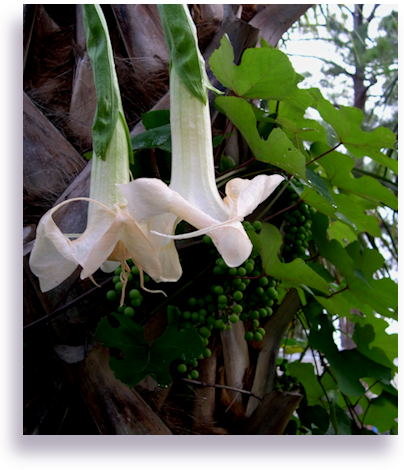Growing Grapes in
Zone 10A
 Classic European Grapes (Vitis vinifera) require dry, hot summers in order to setfruit properly. They are hardy from Zones 6 to 9. These cultivars are usually mild and sweet, and best eaten fresh or made into raisins. Of course, they make great table wines too.
Classic European Grapes (Vitis vinifera) require dry, hot summers in order to setfruit properly. They are hardy from Zones 6 to 9. These cultivars are usually mild and sweet, and best eaten fresh or made into raisins. Of course, they make great table wines too.
Hot and humid summers being the norm for me, viniferas are cultivars I avoid growing. Do yourself a favor right now. Don't attempt growing the European varieties if you have this type of summer climate. The constant fight to keep the plants alive, the fungus and insect issues, and yes, eventual death of the plant; are all ultimatums you will be subjecting yourself to.
Instead, there are many American grape cultivars (Vitis labrusca and others) that are intentionally hybridized for our tempermental weather and not only resist pests and disease in our climate, but thrive. Set yourself up for ease in care and success and choose these cultivars instead. They tolerate wet weather, cold winters and many of the pests we have here in the states.
'Reliance,' 'Concord,' 'Thomcord,' 'Flame' and 'Canadice' are just a few of the strains available that grow well here. Muscadine grapes also grow great in the states, and many cultivars make excellent table wines. Make sure to read up on the types before choosing, grape vines live very long lives and will be with you for generations should you care for them in earnest.
Muscadines are adapted to Zones 7 through 10. Today's cultivars make for good eating, jelly and drying, not just wine as was their original, staple use. They produce small clusters of grapes, some now quite large.
Grapes are self-fertile, except for some muscadine cultivars. Self fertile types are called those with 'perfect flowers,' meaning one flower has both male and female reproduction capabilities, and will produce a berry. Imperfect flower cultivars will need a cross pollinator planted nearby in order to get fruit set.
 Grapes like a slightly acidic soil, and a PH of between 5.0 and 6.0 is perfect. Do not plant them where wild grapes have grown in the past, nor in a pocket that gathers frost in winter. Make sure the site you choose will receive full sun in summer, and that the soil drains freely.
Grapes like a slightly acidic soil, and a PH of between 5.0 and 6.0 is perfect. Do not plant them where wild grapes have grown in the past, nor in a pocket that gathers frost in winter. Make sure the site you choose will receive full sun in summer, and that the soil drains freely.
Grapes, whether young or older, more established vines, do not like nitrogen at levels considered normal to other types of plants. No matter what fertilizer you choose, cut the rate of Nitrogen in half for them. If you don't, you can seriously damage the younger plants, and cause detriment to even the older vines. Although there are different camps on when to apply, you are mostly considered safe to apply fertilizer just before buds begin to break in early spring.
For an excellent in∼depth reading on all of the fertilizer and micronutrient needs of grapes, read this article put out by professional growers, and published by Agronomic Library
A Guide to Fertilizing Grapes
Dig out every single weed in the grape vine bed before their arrival. Ideally, this is done a year before you plant them out. Also add any soil ammendments you need to condition and build the soil at that time. A cover crop of sweet clover or buckwheat can be planted and then tilled under before they arrive. This will help to build the soil as well. Test the PH and adjust it accordingly.
Grape vines will also need support. If you are going to build an arbor, do it first. If you are going to place them in rows, a trellis support will do just fine. You can take 8 foot fence posts, available at Lowes for around 4.00 each, and sink them into concrete in pre-dug hole about 3 foot down. Put them every 4 to 6 feet apart if you expect them to hold the weight of the grapes and vines as they mature. That makes for a 5 foot trellis post. String strong wire in 3 even hrizontal lengths between the posts. You will be training the vines to grow along these wires.
The training of young vines is not really a hard process. Since the new vines will naturally seek out the top trellis wire, and gravity will help pull them back down as they begin to get top heavy, it is an easy task to train them in neat horizontal rows along the wires. Training them up an arbor makes for harder harvesting, but in itself adds beauty to any yard.
The first year, cut the vine back to only two or maximum of three buds. Make sure those two buds are above the area where the vine was grafted. You can always tell where that is by noticing a swelled area and healed wound on the lower trunk of the vine. That is where the two different cultivars were seamed together. Allow the vine to grow steadily the first year. Tie it carefully around the trellis wires to steadily train it as to where you want it to stay. Be sure you leave open space for air to circulate, and use all of the trellis wire that you have strung to train the different branches on. This first year, even though you will be tempted to taste them, you should remove all of the flower buds. This allows the plant to concentrate on growing a thick and healthy root stock. Also rub off any shoots that might appear below the grafting union. Those will be branches of the root stock, and undesirable.
In the fall, mulch the base of the vines if you live in a very cold climate. After the dead of winter and you know that the worst weather is past, prune the vine by selecting two or three (depends upon how many trellis wires you strung) of the healthiest and thickest canes and allowing them to be the leaders. Save these leaders down to two or three buds, and cut off all the rest of the growth.
If the cultivar did not reach your trellis top, you will need to pick a central leader, or main trunk. Pick the straightest and strongest of all the branches that is at least the closest to the trellis top wire. Cut off all other branches flush with the main trunk. Tie the main trunk loosely to the trellis and then cut off any growth that was above the top wire.
Come next summer, allow the highest 5 or 6 buds to develop into sideshoots and grow along horizontally. Tie them loosely to the trellis wire as they grow along it, to train them into place. Cut off any sideshoots (but not leaves) that form upon the main trunk. Again, remove the flower clusters that would have been your grapes.
In your second winter, choose two sturdy, pencil sized canes, each pointing opposite of one another on the trellis, and tie them loosely to it. Rub off any extra buds, and leave only one bud ever 4 to 6 inches. Now cut the canes so that each cane only has about 10 buds. Cut any remaining canes flush to the trunk.
The third summer you will finally taste some of the fruits of your labor. Each of the buds you had left this past winter will now produce a fruiting branch. Remove most of it's flower clusters, leaving only 5 or 6 to turn into grapes. Keep the main trunk clear of any shoots that try to spurn off, and make sure no buds try to survive below the graft union.
Tags: grow grapes, muscadines, care and grow grapes, muscadines, grow grapes in zone 10A, grow grapes in the south, vitis, southern grape growing,






